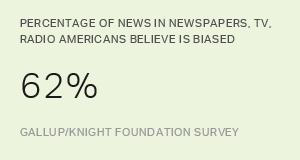The rise of digital news sources in the last several decades has greatly changed the media environment and, for most Americans, their news consumption habits. More than one-half of U.S. adults (55%), for instance, visit internet-only news websites on a frequent basis, according to the 2017 Gallup/Knight Foundation Survey on Trust, Media and Democracy. In fact, Americans are equally likely to get their news from social media sites as they are from newspapers.
On balance, most Americans (57%) see the internet as having had a positive impact on the U.S. news environment in the past ten years, but it has also created its own set of challenges. Notably, news consumers may find it difficult or time-consuming to sort through the vast amount of information and news sources available through digital media -- this may be one reason why the Gallup/Knight survey found that 58% of Americans believe it is hard to stay well-informed in today's media environment.
To help sort through this abundance of content, many Americans use information provided by websites and other digital media platforms. Two popular types of information these outlets use include indicators of collective opinion or a person's own past behavior. For instance, users of social media sites are regularly suggested news stories (as well as other types of content) which are popular within their social network or people with similar interests. Many websites also use users' past viewing behavior to select or promote content.
If this type of information is being used to help steer content to digital news consumers, then it is important to understand how it may alter or influence individual trust perceptions. To help investigate this issue, as well as part of its larger research into trust and the media, Gallup and the John S. and James L. Knight Foundation conducted an online experiment.
Is Trust in Media Influenced by Collective Opinion?
In this experiment, participants were given access to a custom-built news aggregation platform, where they could view the headlines of the latest political, economics and science stories from seven prominent news sources. Participants could view the full article by clicking on the headline; if they viewed the full article, they were also asked to rate how much they trusted the piece on a 1 to 5 scale.
In total, 11,695 individuals participated in the study. They were divided into five experimental groups and one control group. Those in the five experimental groups saw at least one of the following metrics when viewing an article:
- Personal average trust score: This score indicated the reader's average trust score for the news outlet which produced the story they were currently viewing, based on the reader's ratings either before the study or at an earlier point in the study. For instance, if somebody clicked on an Associated Press story, this metric would tell them what their average trust score was for all AP stories they had read on the platform in the past.
- Community average trust score: This score indicated the average rating that all users of the experimental news platform had given to a certain news outlet's stories in the past.
- "People like you" average trust score: This score indicated the average trust rating for a news outlet among certain platform users who were determined to be "similar" in an attitudinal or demographic sense.
As can be seen in the below table, participants who saw their personal average trust score tended to rate the articles they read more highly than the other groups, including the control group. The average trust score of those who saw only the community or "people like you" averages the lowest of all other groups, including the control group. Participants who saw their personal score alongside either of the other two metrics fell somewhere in-between these points.
| Mean Trust Rating | ||||||||||||||||||||||||||||||||||||||||||||||||||||||||||||||||||||||||||||||||||||||||||||||||||||
|---|---|---|---|---|---|---|---|---|---|---|---|---|---|---|---|---|---|---|---|---|---|---|---|---|---|---|---|---|---|---|---|---|---|---|---|---|---|---|---|---|---|---|---|---|---|---|---|---|---|---|---|---|---|---|---|---|---|---|---|---|---|---|---|---|---|---|---|---|---|---|---|---|---|---|---|---|---|---|---|---|---|---|---|---|---|---|---|---|---|---|---|---|---|---|---|---|---|---|---|---|
| (1-5) | ||||||||||||||||||||||||||||||||||||||||||||||||||||||||||||||||||||||||||||||||||||||||||||||||||||
| Experimental Group | ||||||||||||||||||||||||||||||||||||||||||||||||||||||||||||||||||||||||||||||||||||||||||||||||||||
| 1: Personal average only | 3.11* | |||||||||||||||||||||||||||||||||||||||||||||||||||||||||||||||||||||||||||||||||||||||||||||||||||
| 2: Community average only | 3.02*** | |||||||||||||||||||||||||||||||||||||||||||||||||||||||||||||||||||||||||||||||||||||||||||||||||||
| 3: "People like you" average only | 3.00*** | |||||||||||||||||||||||||||||||||||||||||||||||||||||||||||||||||||||||||||||||||||||||||||||||||||
| 4: Personal and "people like you" averages | 3.08 | |||||||||||||||||||||||||||||||||||||||||||||||||||||||||||||||||||||||||||||||||||||||||||||||||||
| 5: Personal and community averages | 3.05 | |||||||||||||||||||||||||||||||||||||||||||||||||||||||||||||||||||||||||||||||||||||||||||||||||||
| 6: Control group | 3.07 | |||||||||||||||||||||||||||||||||||||||||||||||||||||||||||||||||||||||||||||||||||||||||||||||||||
| *Mean values are statistically significant across experiment groups at three significance levels (*p<0.05, **p<0.005, ***p<0.001). Asterisks indicate that the mean trust rating of the experimental group differs from the control group in a statistically significant manner. | ||||||||||||||||||||||||||||||||||||||||||||||||||||||||||||||||||||||||||||||||||||||||||||||||||||
| GALLUP | ||||||||||||||||||||||||||||||||||||||||||||||||||||||||||||||||||||||||||||||||||||||||||||||||||||
These results suggest news consumers who saw only the community or "people like you" trust ratings tended to be more skeptical of the material they read, even when this material disagreed with popular opinion. On the other hand, those participants who saw only their own personal history averages tended to rate the articles they read just as highly as they had in the past, perhaps in a desire to remain consistent in their attitudes. The effect of seeing the personal rating in combination with either the community or the "people like you" statistic, meanwhile, appears to have offset the effect of the other rating, which may be why these groups' trust levels were closer to that of the control group.
To further understand how these metrics might influence overall trust perceptions, it is useful to compare how study participants' trust ratings appeared to change over the course of the experiment. Prior to the beginning of the experiment, participants were allowed to use the news aggregation to read and rate articles -- slightly less than half (5,126) did so.
For these participants, it is possible to compare their trust attitudes before the experiment and during the experiment. The typical trust ratings of participants who viewed either a community or a "people like you" average dropped by a statistically significant amount throughout the experiment, relative to how those users rated articles before the experiment. This further suggests that viewing either of these metrics in isolation may have diminished the amount of trust readers had in a story, perhaps in response to the opinion conveyed by the statistics.
| Average trust rating before the experiment | Average trust rating during the experiment | |||||||||||||||||||||||||||||||||||||||||||||||||||||||||||||||||||||||||||||||||||||||||||||||||||
|---|---|---|---|---|---|---|---|---|---|---|---|---|---|---|---|---|---|---|---|---|---|---|---|---|---|---|---|---|---|---|---|---|---|---|---|---|---|---|---|---|---|---|---|---|---|---|---|---|---|---|---|---|---|---|---|---|---|---|---|---|---|---|---|---|---|---|---|---|---|---|---|---|---|---|---|---|---|---|---|---|---|---|---|---|---|---|---|---|---|---|---|---|---|---|---|---|---|---|---|---|
| (1-5) | (1-5) | |||||||||||||||||||||||||||||||||||||||||||||||||||||||||||||||||||||||||||||||||||||||||||||||||||
| Experimental Group | ||||||||||||||||||||||||||||||||||||||||||||||||||||||||||||||||||||||||||||||||||||||||||||||||||||
| 1: Personal average only | 3.31 | 3.28 | ||||||||||||||||||||||||||||||||||||||||||||||||||||||||||||||||||||||||||||||||||||||||||||||||||
| 2: Community average only | 3.27* | 3.14* | ||||||||||||||||||||||||||||||||||||||||||||||||||||||||||||||||||||||||||||||||||||||||||||||||||
| 3: "People like you" average only | 3.31* | 3.18* | ||||||||||||||||||||||||||||||||||||||||||||||||||||||||||||||||||||||||||||||||||||||||||||||||||
| 4: Personal and "people like you" averages | 3.31 | 3.31 | ||||||||||||||||||||||||||||||||||||||||||||||||||||||||||||||||||||||||||||||||||||||||||||||||||
| 5: Personal and community averages | 3.25 | 3.23 | ||||||||||||||||||||||||||||||||||||||||||||||||||||||||||||||||||||||||||||||||||||||||||||||||||
| 6: Control group | 3.33 | 3.30 | ||||||||||||||||||||||||||||||||||||||||||||||||||||||||||||||||||||||||||||||||||||||||||||||||||
| *Average trust rating before the experiment compared with during the experiment differed at a statistically significant level of p<0.05. | ||||||||||||||||||||||||||||||||||||||||||||||||||||||||||||||||||||||||||||||||||||||||||||||||||||
| GALLUP | ||||||||||||||||||||||||||||||||||||||||||||||||||||||||||||||||||||||||||||||||||||||||||||||||||||
However, trust levels did not vary over the two periods in a statistically significant way for participants who saw only their personal average score. As is discussed further in the full report on this experiment, one way to interpret this finding, which is supported by past research, is that reminders of past behavior encourage people to remain consistent in their attitudes.
Implications
Generally, the experiment shows that reminding readers that they are looking at a news story based on what others have trusted or liked in the past does not enhance its credibility, and in fact, may decrease its credibility. This means that curated news sources, such as Facebook News, may result in less legitimation of what people read, assuming they are aware that the news stories are selected based on algorithms that projected what similar people like and read.
Read more here.




